This weekend hosted the final round of Bundesliga fixtures which saw Hoffenheim travel to the Signal Iduna Park to take on Borussia Dortmund. Going into the game, Hoffenheim were currently sitting in 7th place, and needed to win against Borussia Dortmund and hope that Vfl Wolfsburg lost in their home game against Bayern Munich to guarantee them a place in the UEFA Europa League next season.
Dortmund, on the other hand, were going into the game having already cemented their place in next seasons UEFA Champions League competition by finishing in 2nd place, regardless of the result in this game. It was the away side that clearly proved they are the right fit for European football next season, having come to Dortmund with a new bout of confidence under interim boss Matthias Kaltenbach as they played Dortmund off the park.
In this tactical analysis, we will look at Hoffenheim’s build-up play which allowed them to progress through the thirds successfully, as well as highlighting Dortmund’s lack of quality in possession. The analysis will conclude by examining Dortmund’s defensive issues in their back three that saw the game finish 4-0 in favour of Hoffenheim.
Lineups
For Dortmund’s last home game of the season, Lucien Favre set out his side in a 3-4-3 formation and made several changes from their last game which was a win at RB Leipzig. Roman Bürki started in goal with a back three of Mats Hummels, Leonardo Balerdi and Łukasz Piszczek. Dortmund’s midfield four consisted of Raphaël Guerreiro as the left-sided attacking full-back, Axel Witsel and Julian Brandt in the centre and Mateu Morey as the right-sided attacking full-back. Their front three was Giovanni Reyna, Erling Braut Håland and Thorgan Hazard.
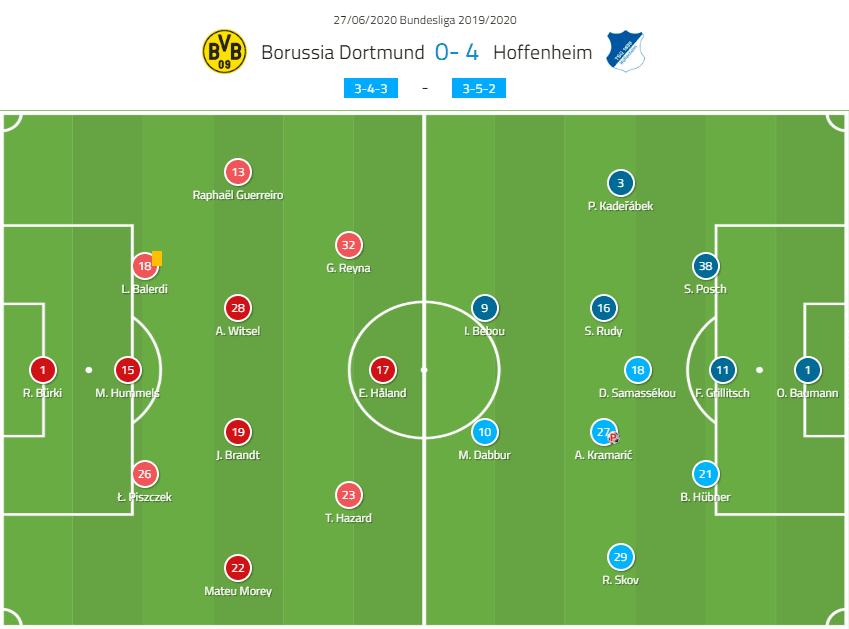
As for Hoffenheim, Matthias Kaltenbach set up his side in a 3-5-2, a formation that Hoffenheim are very used to playing this season. Oliver Baumann started in goal, with a back three consisting of Stefan Posch, Florian Grillitsch and Benjamin Hübner. Their holding midfielder of the midfield five was Diadie Samassékou, with Andrej Kramarić and Sebastian Rudy playing just in front. Robert Skov and Pavel Kadeřábek acted as the attacking wing-backs, with Ihlas Bebou and Moanes Dabour as the two strikers.
Hoffenheim’s build-up play to progress forwards
Hoffenheim entered this game looking to confirm their places in the UEFA Europa League and continue their winning form under their interim boss Katterbach. Throughout the game, they managed to build up the play using both the central and wide areas and were very successful when doing so. When they built the play in the central area, they would break the Dortmund lines with penetrative through passes. When Hoffenheim found themselves in the wide areas during their build-up, they would create overloads which allowed them to keep progressing forwards in these areas.
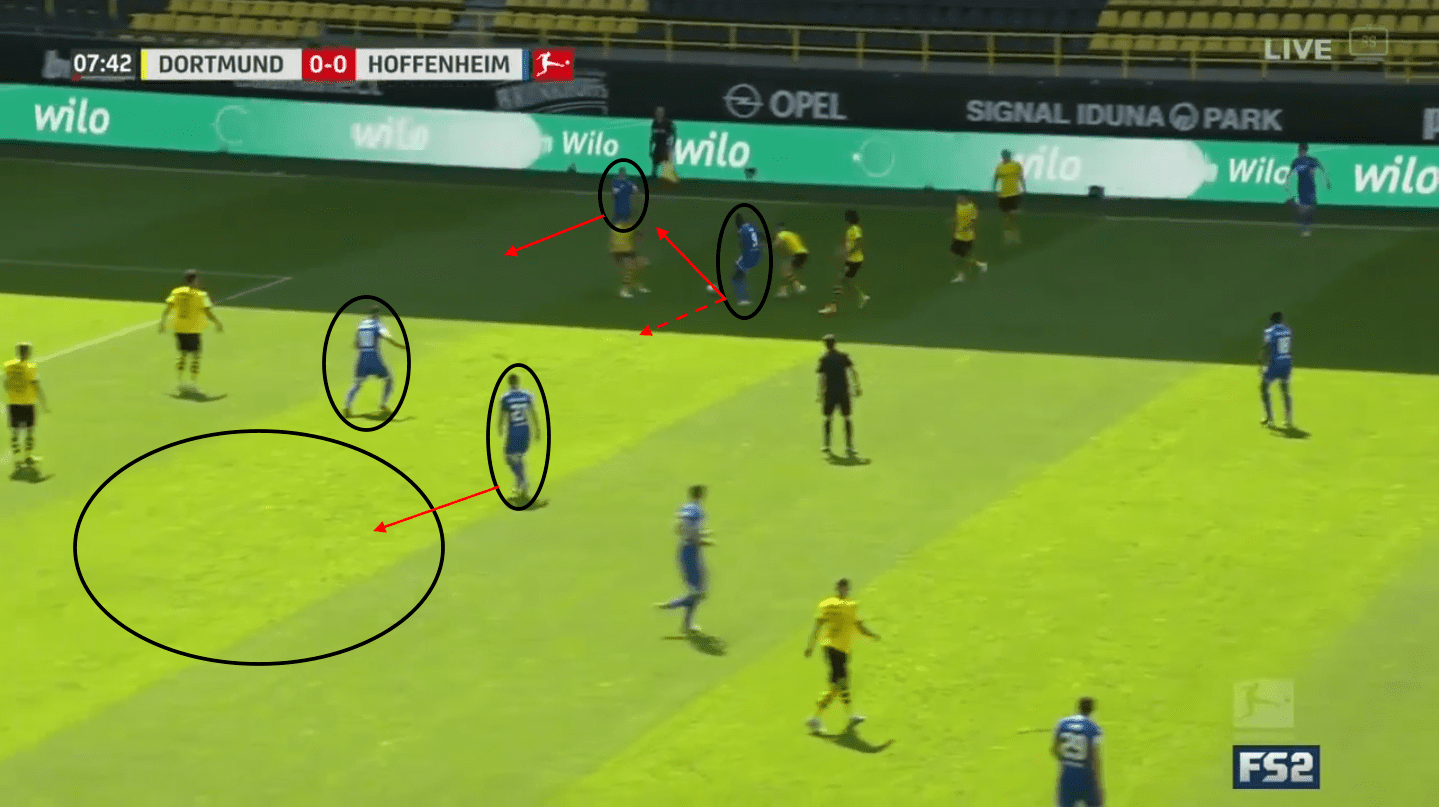
In this first example which led to Kramarić’s first of four goals, Hoffenheim create a 2v1 overload on the edge of the right half space. As Bebou receives a forward pass, he turns and dribbles forwards through the press of Witsel and Brandt. This movement forwards attracts Balerdi to come and press, creating an overload with Bebou and Kadeřábek. Bebou was able to play to Kadeřábek, who cut the ball back for Kramarić in the central space to shoot and score.
It should be noted that before this action, Posch vacated the half space, which allowed Bebou to receive and turn and Kadeřábek to make a run to the right-wing to support. This rotation in their build-up caused Dortmund all sorts of problems.
Hoffenheim have an 89% medium pass completion percentage and 67.9% long pass completion rate. Throughout their campaign this season under Alfred Schreuder, they have built up the play through the central areas, using their pivot players to make this passage of play successful. One of the main players that make their build-up play so effective is Grillitsch, who has made 92.9% of his passes this season accurate to a teammate.
The use of Grillitsch in this game against Dortmund was key to their build-up penetrating the defensive lines. Kaltenbach played Grillitsch in a deeper central defensive role and proved key to their success in their build-up stage.
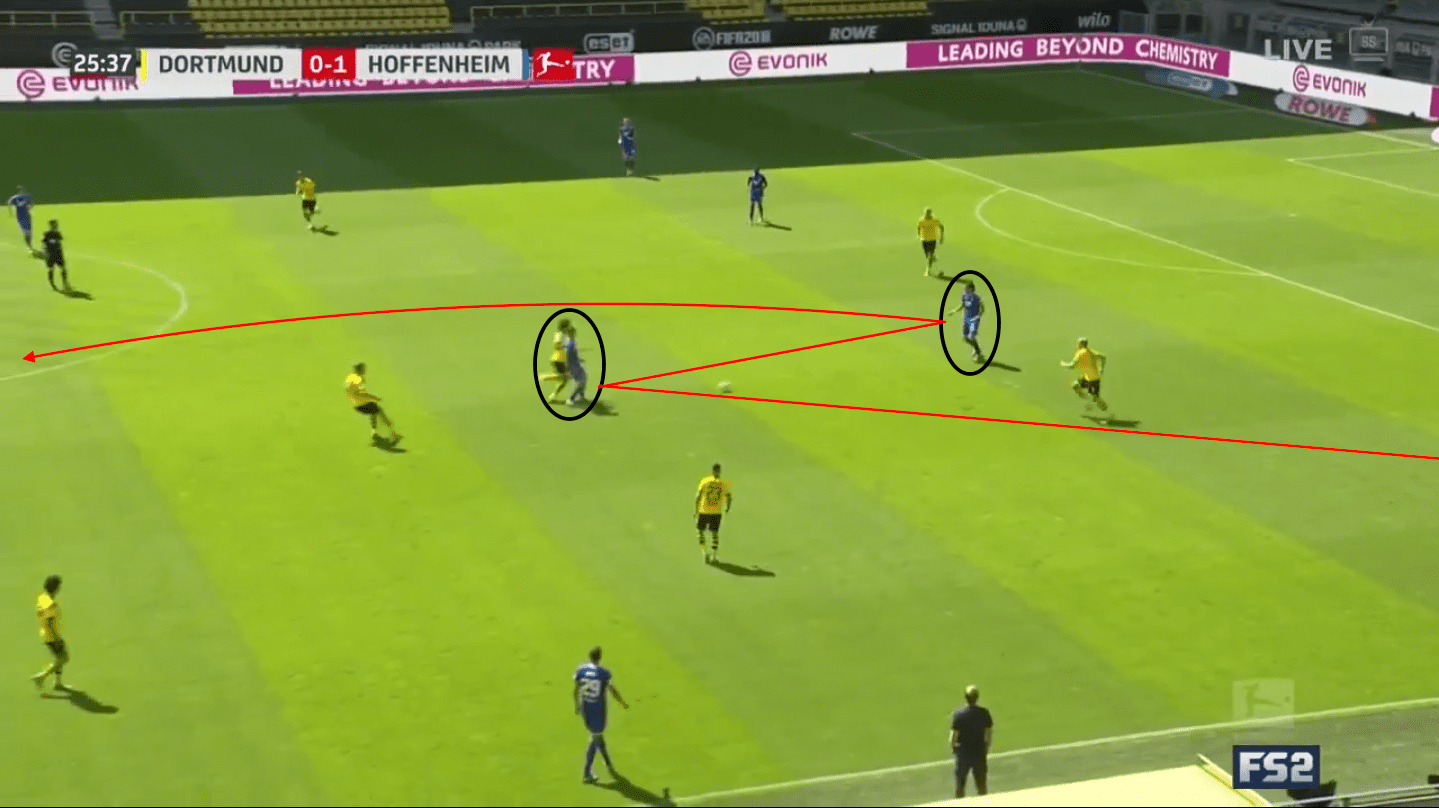
As Hoffenheim look to build the play to search for the second goal, Grillitsch, as well as their defensive midfield player, are involved in making this transition through the thirds a success. Baumann plays the ball to Hübner, who looks to start the build-up play and progression of the ball forwards. He plays the ball into Samassékou, who drops deep to receive, which attracts Witsel to follow him and provide pressure. As Samassékou has the ball, he plays it back to Grillitsch, who then plays a through pass into Dabour. Hoffenheim see themselves into the Dortmund half and have broken two of their defensive lines with penetrative build-up passes.
Grillitsch and Samassékou again link up to build and beat the press of Dortmund as we see in the example below.
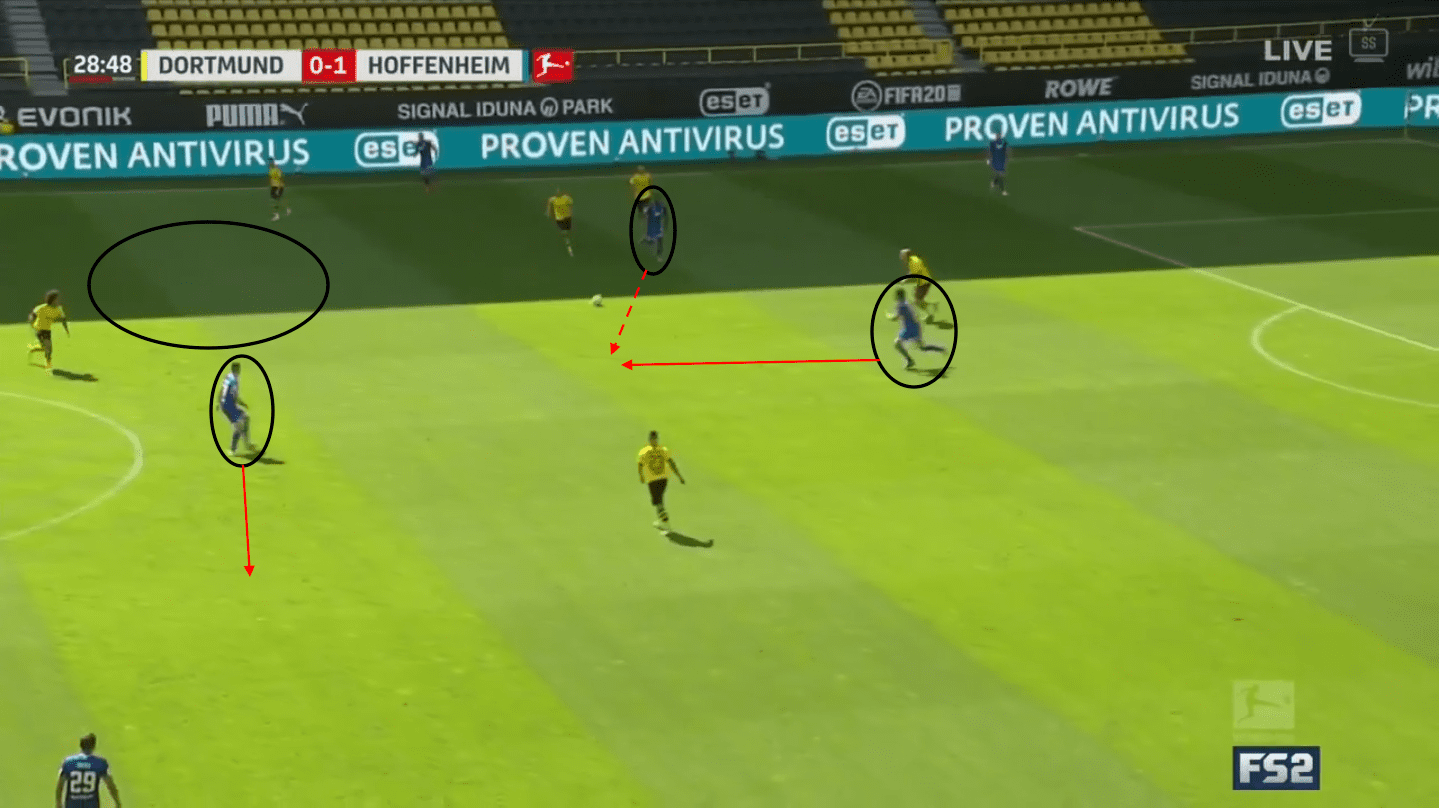
Samassékou receives the ball deep from Posch, who then turns and plays the ball into the path of Grillitsch. Once he is in possession, he then looks to build the play through Dortmund’s second line of press by dribbling forwards to invite pressure and then plays a forward pass into the strikers’ feet once more.
Hoffenheim have taken 9970 touches of the ball this season in the midfield third, more than the final and defensive thirds. They have successfully completed 58.3% of their dribbles when in possession of the ball. When in the wide position in their own half, they still looked to create overloads to keep progressing forwards.
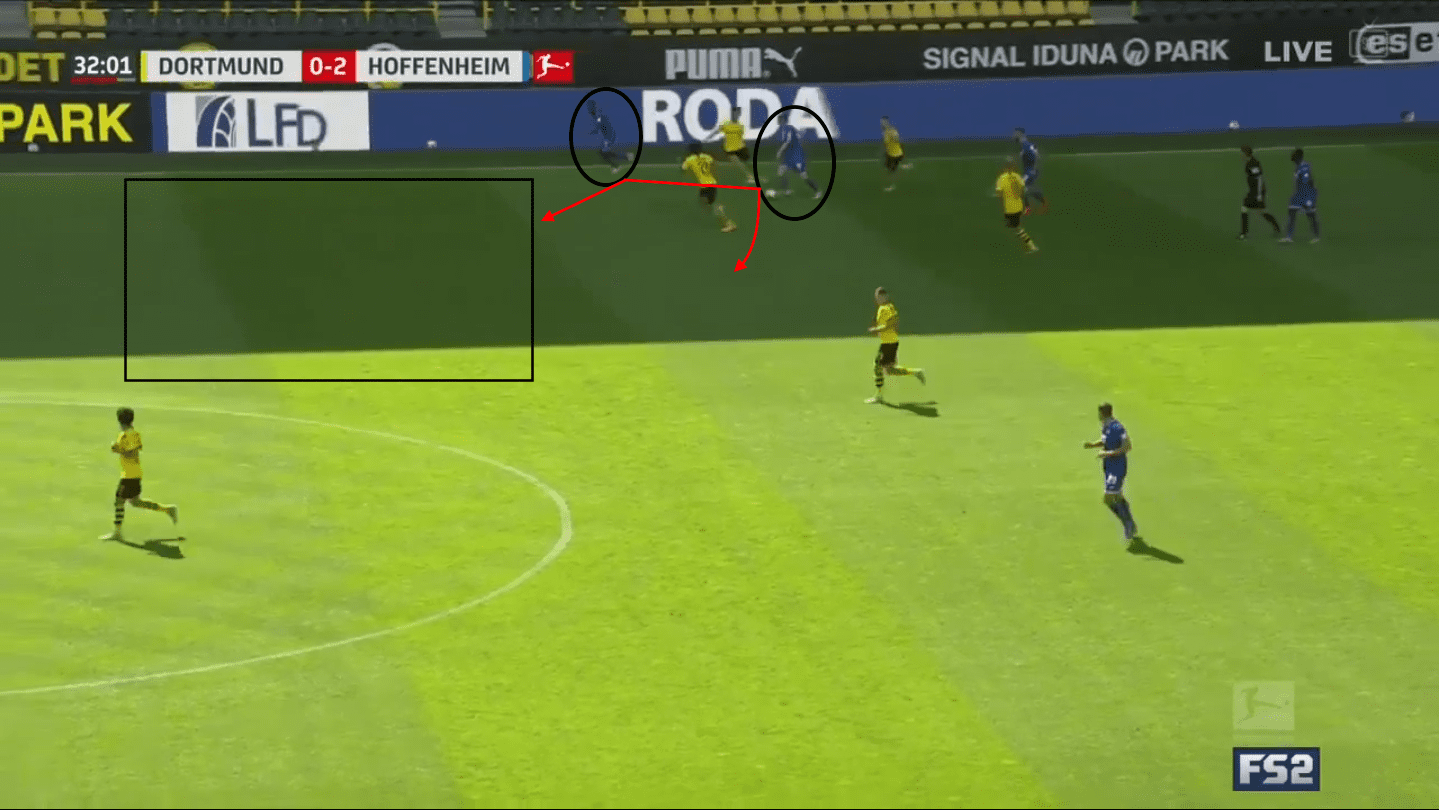
Posch and Bebou are seen to create an overload scenario in the image above, which sees Hoffenheim break out of the Dortmund press in their build-up and can continue to take the ball forwards into the vacated space.
In the second half, we again saw Hoffenheim use the ‘up, back, through’ approach to their build-up, which involved Posch, Bebou and Samassékou.
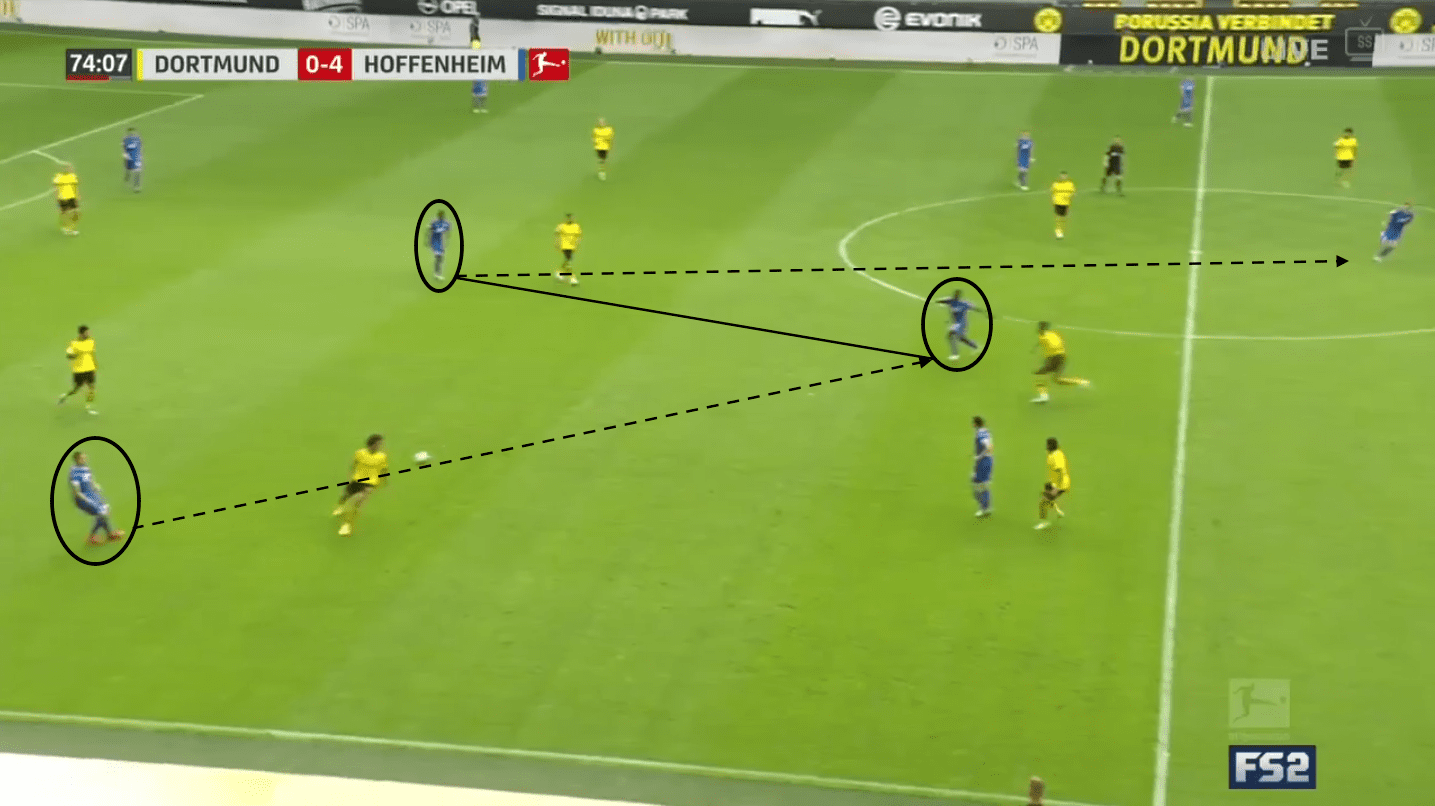
Posch has the ball in the right-hand wide position and, even at 4-0, they look to build the play to progress the ball forwards once more. Posch recognises that Bebou has dropped deep to receive, which again draws the Dortmund midfielders to follow, creating space behind. Bebou lays the ball off to his holding midfielder Samassékou, who then plays a forward, through pass into Baumgartner who looks to receive in the created space in between the lines.
Hoffenheim were dominant with their build-up play to progress and used a through approach to get past Dortmund’s out of possession structure. They also used the wide areas on some occasions where the use of overloads allowed them to be successful in their build-up in different areas of the pitch.
Dortmund’s lack of quality and support in possession
Borussia Dortmund saw lots of the ball in this game, having had 60% possession of the ball. However, their lack of quality when in possession of the ball, as well as failing to penetrate Hoffenheim in key areas contributed to their poor performance to finish off the season. Dortmund have averaged 60.74% possession this season and scored 84 goals. They average 2.47 goals per 90 and are way ahead of their xG tally of 58.8.
When Dortmund found themselves in possession in this game, they lacked any quality with the ball and failed to support the ball carrier which meant the momentum of the attack broke down time after time. If players off the ball were able to support the player in possession then Dortmund could have found a way back into the game.
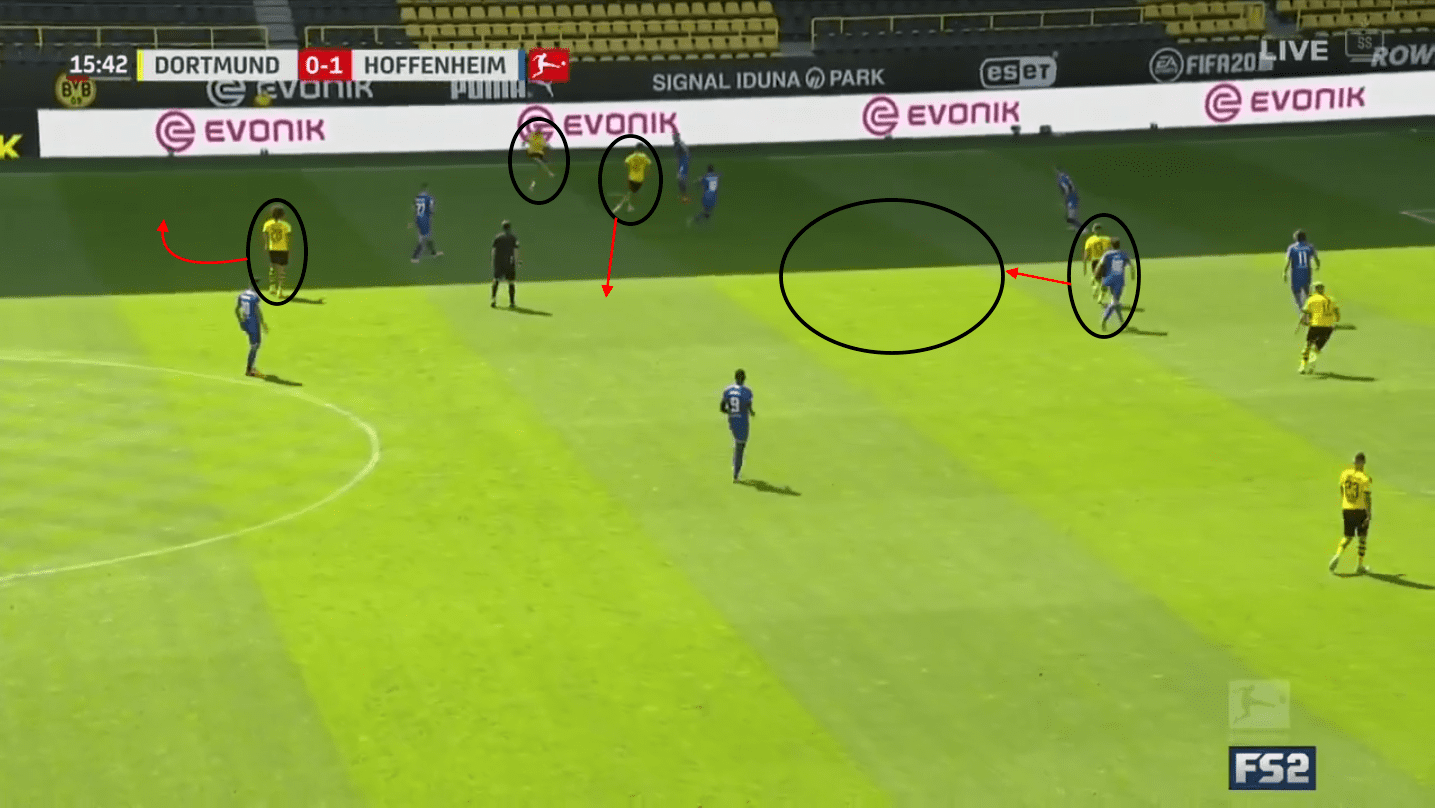
In the early stages, Guerreiro is seen in possession on the left-hand side and is looking for a way to play the ball into the final third, however, he loses possession very easily through a poor forward pass destined for Hazard. Although the timing of the pass from Guerreiro was poor and realistically wasn’t going to find Hazard, he needed more support from his teammates off the ball. Witsel could have made a movement left which would have created an angle for him to receive and could have then switched the point of the attack to isolate. Hazard could have dropped into the pocket of space in-between the lines to receive, which would have created space for Håland in behind.
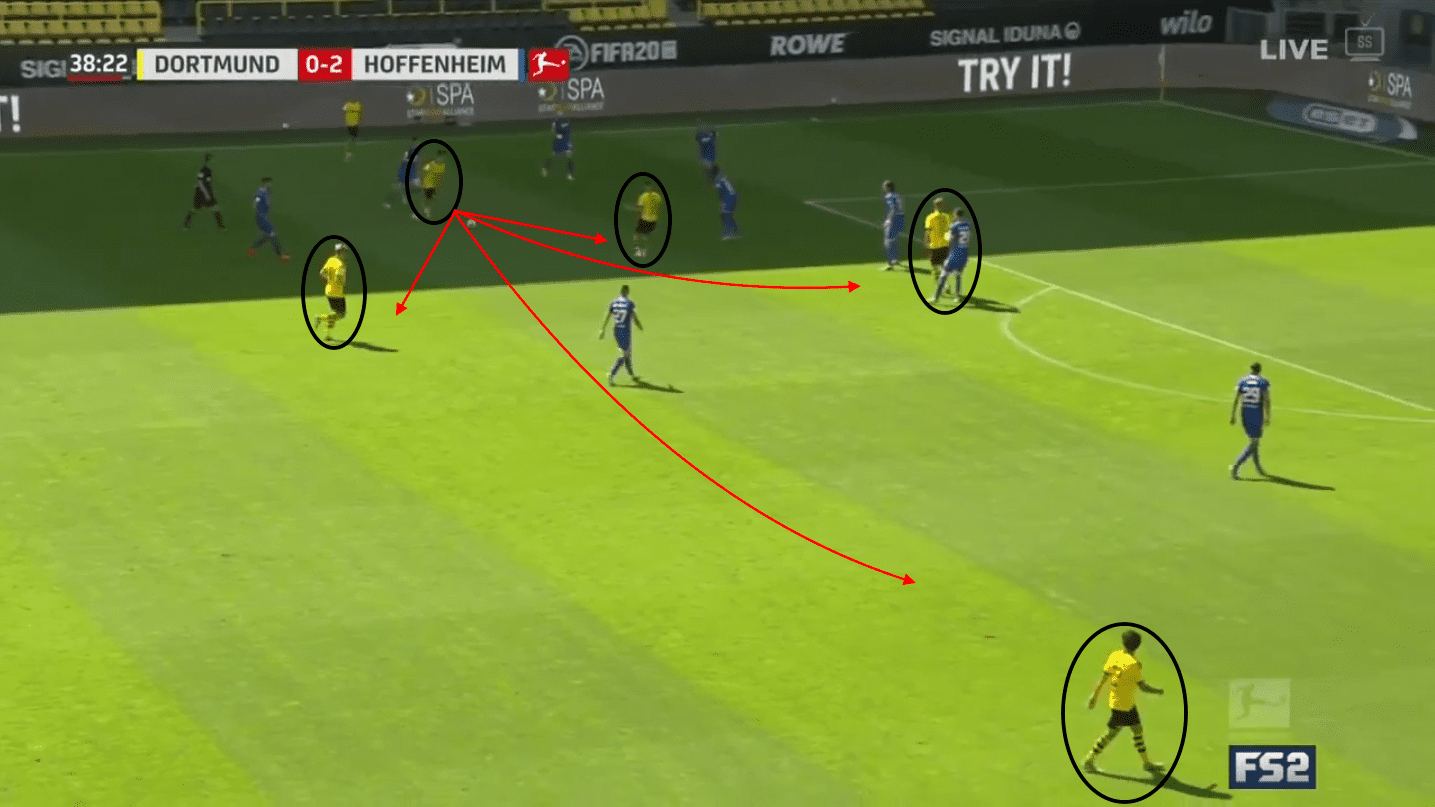
In the latter stages of the game and with a mountain to climb, Dortmund are again careless in possession and lose the ball high up the pitch, allowing Hoffenheim the chance to counterattack, something they were very effective at throughout the whole game.
In this situation, Guerreiro again has the ball in the left half space and has many options around him. He can play short to Brandt, play a long switch to Morey, play short into Hazard or through into Håland. However, Guerreiro spends too long on the ball making a decision and finds himself losing possession with players high up the pitch, giving the chance for Hoffenheim to counterattack and search for their third goal.
A few moments later, after regaining possession from the counterattack, Dortmund look to progress the ball, but quality of the control from Witsel forces Dortmund to lose possession once more.
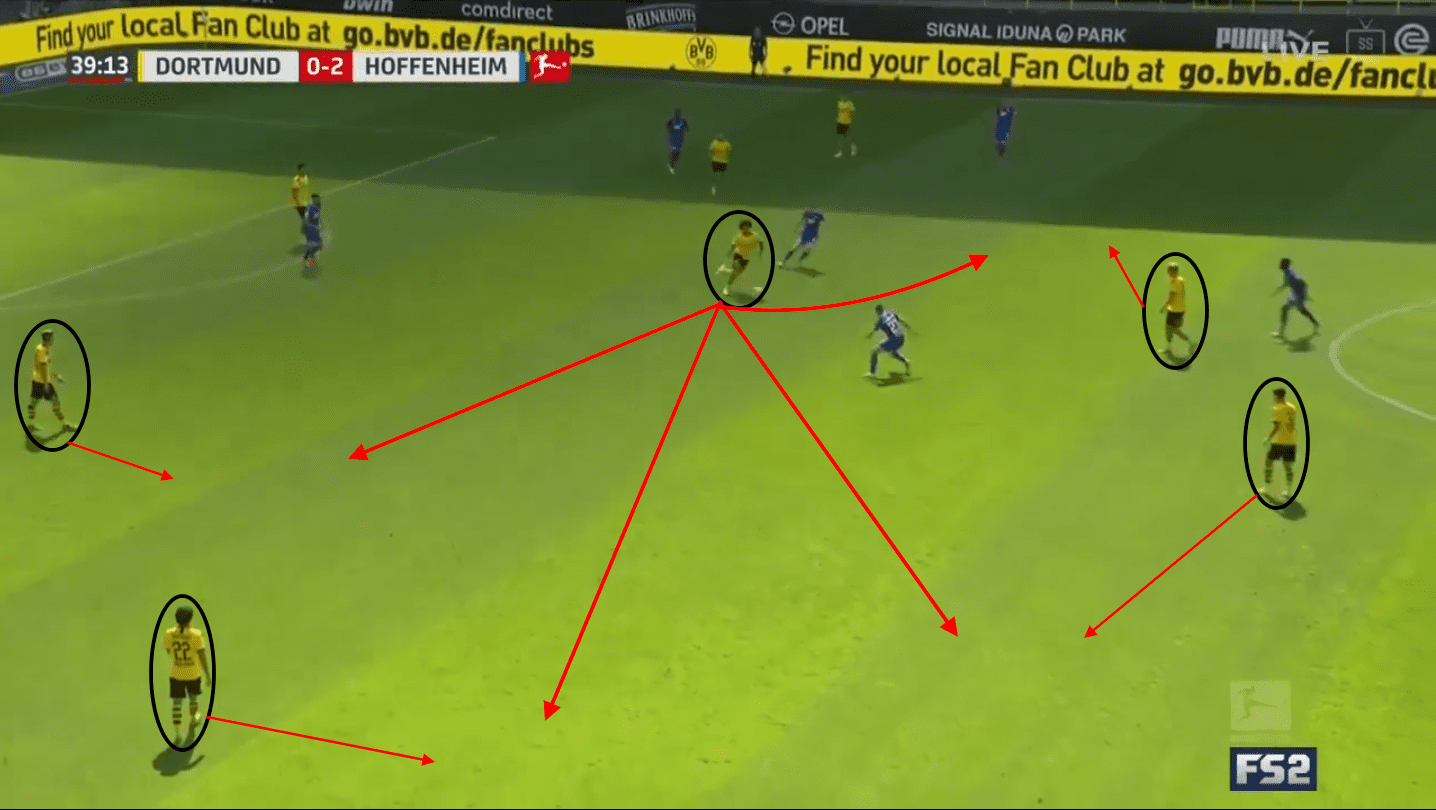
Hummels plays a forward pass into the midfield for Witsel, who fails to offload the ball quick enough and loses possession in a dangerous area. Witsel had many passing options to keep the ball being progressed forwards. It wasn’t all Witsel, it should be mentioned. The supporting players of Piszczek, Morey, Brandt and Reyna fail to move to create angles to receive, which forces Witsel to stay on the ball for too long.
In the second half, their lack of quality and decision making on the ball was seen again, when Reyna fails to control properly and fails to make the right decision when receiving.
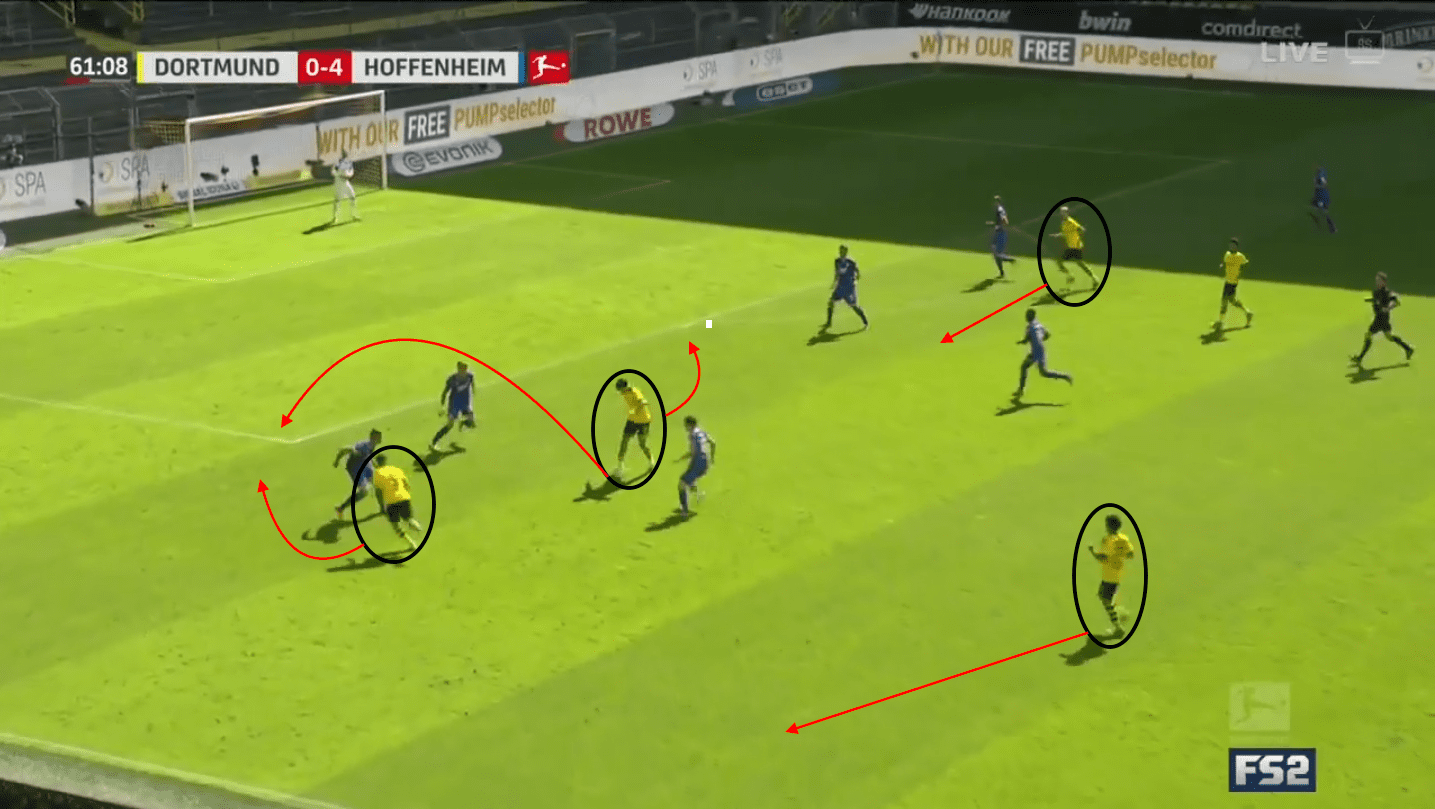
Reyna could have played a first-time ball over the top into the path of the advancing Hakimi, but tries to control and fails to keep hold of the ball through a poor first touch. It could be argued that Morey and Håland could have made better movements to support so Reyna didn’t need to control and could have played first time if he was aware of the support around him.
Dortmund’s positional defensive issues
Going into this game against Hoffenheim, Dortmund had only conceded 35 goals in the league this season which is under their overall xGA tally of 38. They have kept 15 clean sheets during this campaign and only average 1.21 goals against per 90 minutes. Having cemented their place in 2nd and looking ahead at preparations for next season, Dortmund wanted to finish this successful season on a high.
However, it was clear to see that Dortmund entered this game with any real threat going forwards and a total lack of organisation and positional sense in defence. On many occasions, their back three of Hummels, Balerdi and Piszczek constantly found themselves out of position, especially on the Hoffenheim counterattack and gained no support from their wing-backs of Guerreiro and Morey.
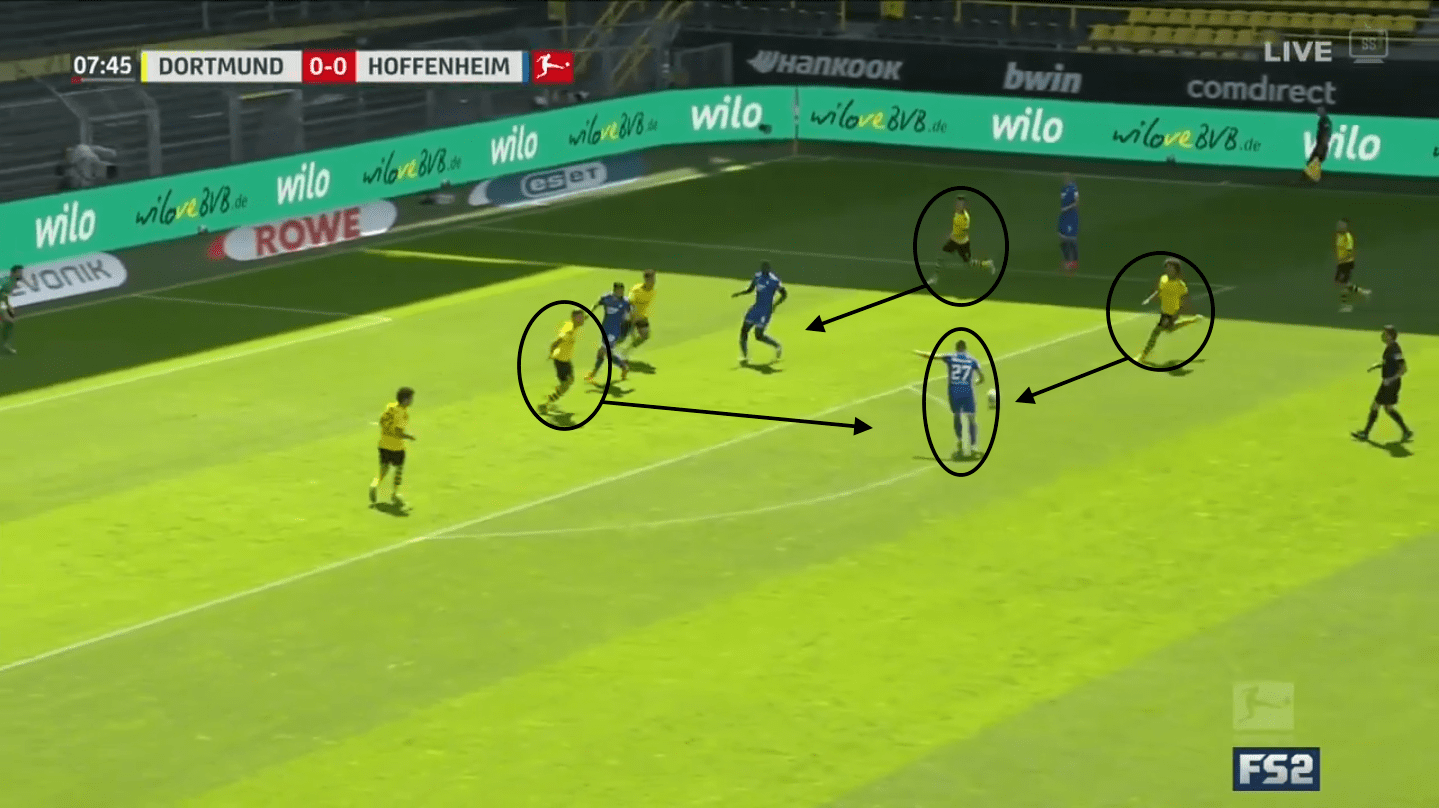
For Kramarić’s first goal that also led to Hoffenheim’s opener early on in the game, he was left unmarked on the edge of the box and managed to receive a square pass across the box and curl the ball into the top corner. This pass, as well as allowing Kramarić from receiving without any pressure, could have been prevented if Dortmund’s defensive players were in better positions to instigate the press.
In the above image, Hummels and Piszczek are very narrow and both find themselves marking Dabour in the penalty area. If Piszczek stepped out and applied pressure when the square ball to Kramarić had been played, this could have prevented him from taking a first time shot to score. Also, Witsel could have made a run across to Kramarić quicker to apply pressure from the front, which could have made him rush the shot or may have been able to regain possession.
This season, Dortmund have applied pressure to an opposing player with the ball 5052 times and 32.4% of the time they have been successful and regained possession. They currently average 9.19 shots against them per 90, however only have an xG per shot against average of 0.12. Having played in a back three for most of the season this campaign, this game shouldn’t have been approached any differently to the rest of their previous games.
For Kramarić’s second goal and Hoffenheim’s second, Dortmund’s poor positional play by their back three was evident once more.
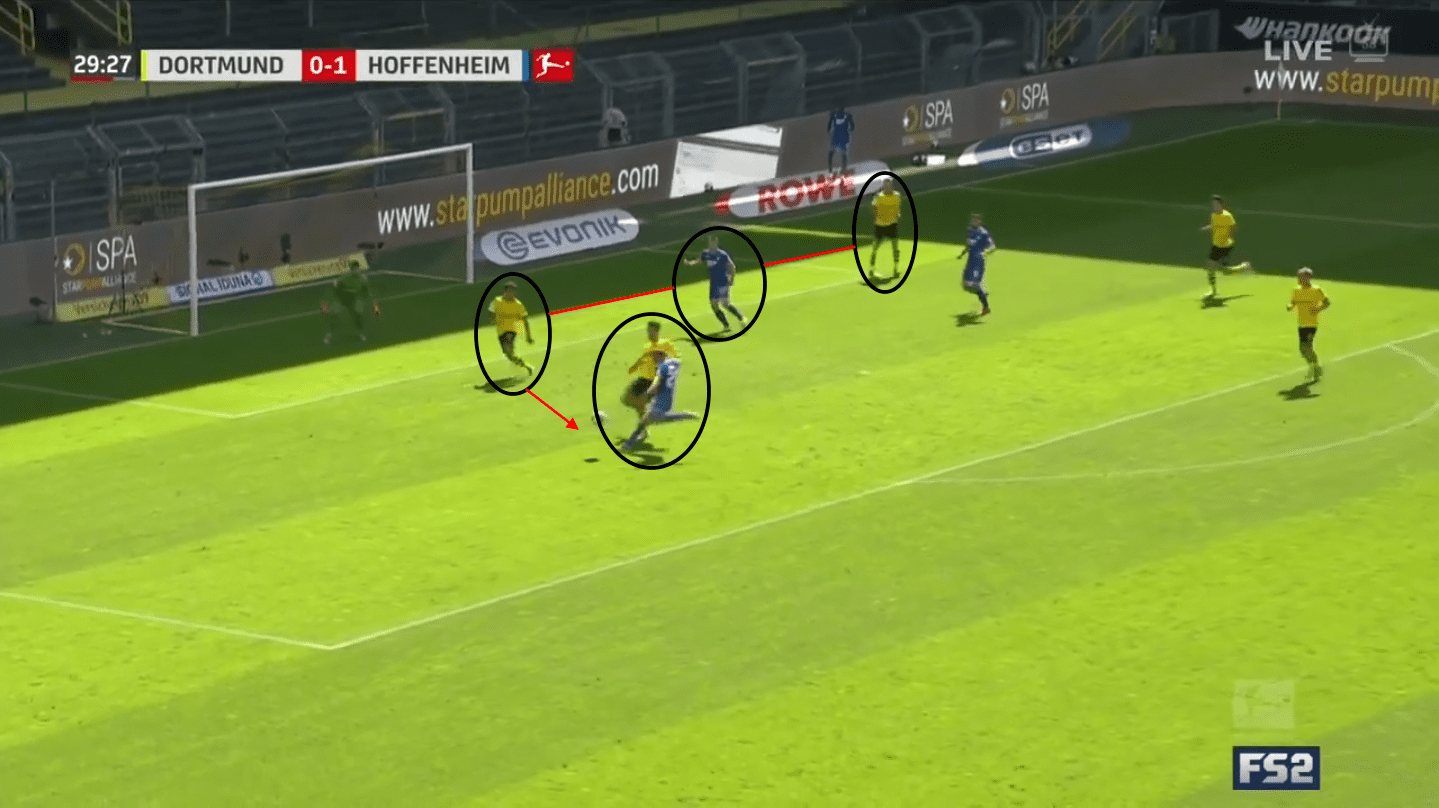
As Skov receives the ball in the Dortmund penalty area and looks for an opportunity to shoot, he decides to cut the ball back onto his right which then leaves a clear passing line to Kramarić who is stood in a central position in between the Dortmund defensive line and can tap in for his second.
To have prevented this goal from being scored, firstly there was no reason for Hummels to go and initiate the initial press. If he had left the first press to Morey, the right-sided attacking full-back who is in line with Skov, then Hummels could have marked goal side of Kramarić, which would have made the back three more organised, in a better position and difficult to break down. It would have also prevented Kramarić from receiving on the six-yard box and being able to tap home with ease.
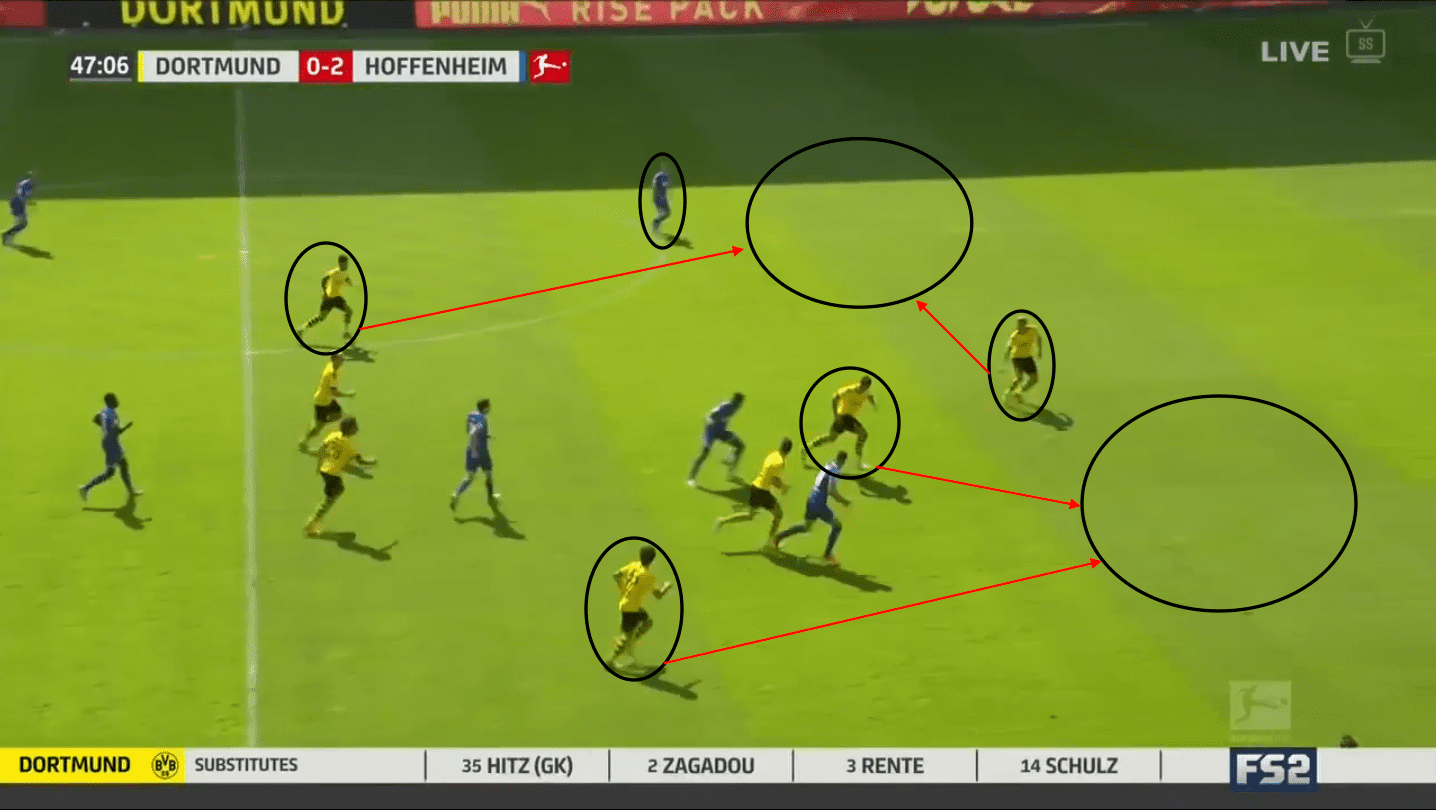
Shortly after half-time, Kramarić is left wide open to receive a pass and score his third of the game. The reason why Kramarić was left in open space and a through pass was able to be produced with ease was due to Dortmund’s poor positional defensive play out of possession.
Hummels once more went to go and press Bebou in possession of the ball. Hummels’ press meant he was then out of position, leaving space behind him for Dabour to run into to exploit. This run from Dabour encouraged Piszczek to come over to naturally provide the cover. What they didn’t notice was Kramarić’s movement unmarked to the left half space, which saw a perfectly timed pass from Bebou into his path to take the ball into the box and complete his hat-trick.
If Hummels had of stayed in his position and left the press to Balerdi, then Piszczek wouldn’t have had to provide cover and could have stayed in his position, marking Kramarić. Also, if Hummels was the person to press in this area, Morey and Sancho needed to make a retreating run to cover the space at the back left by the press from Hummels.
Dortmund are the lowest in the league for defensive duel actions, having only averaging 54.18 defensive duels per 90. Throughout this game, it was clear that their back three, especially Hummels, went to perform the duel action, but other teammates failed to provide the cover and close down the space that appeared.
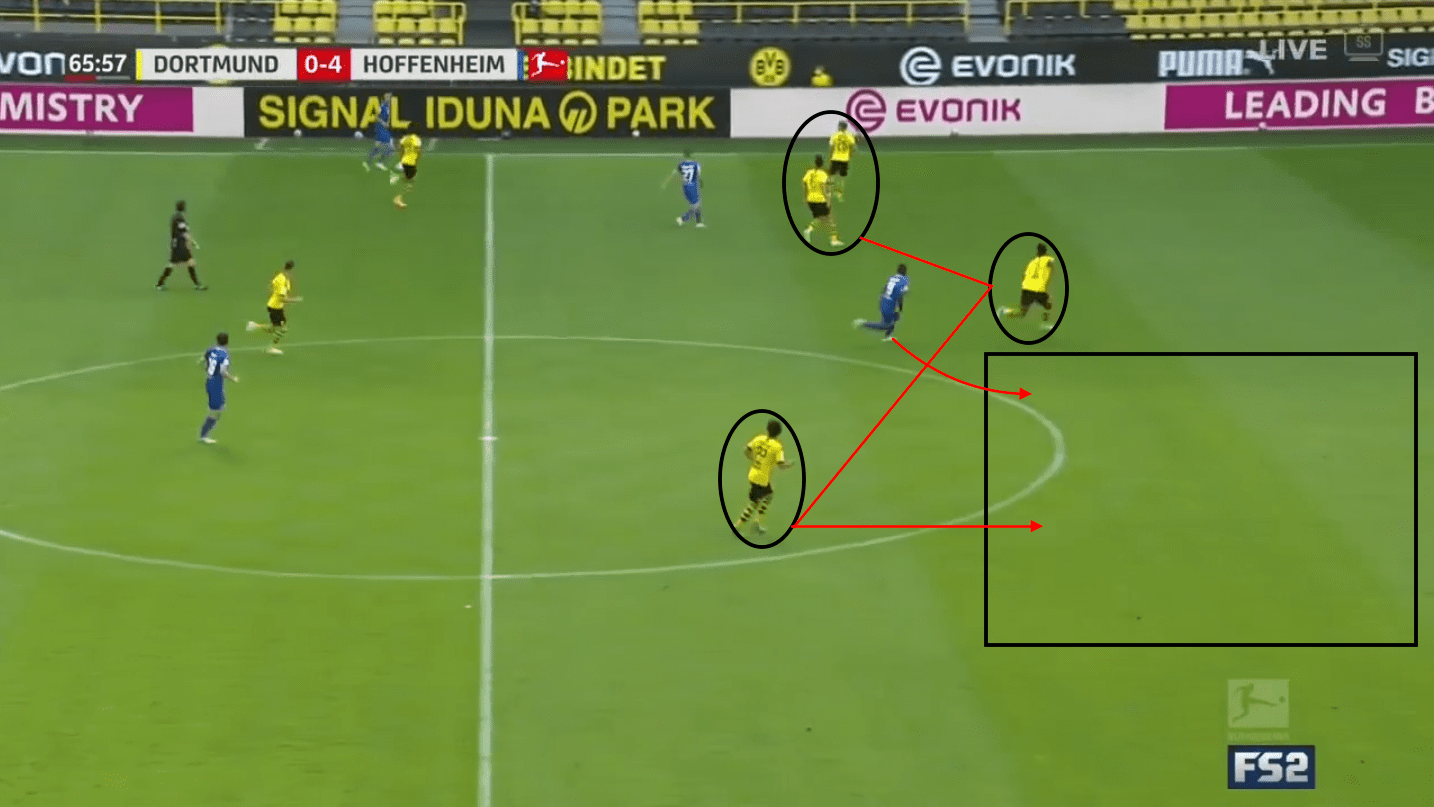
Hummels again goes to press to prevent Baumgartner from receiving, which draws Dan-Axel Zagadou over to cover Bebou’s run, but Morey, as the attacking right full-back, fails to carry out his defensive duties by not running back to provide the cover and balance.
Conclusion
This analysis has examined the tactics used in Hoffenheim’s build-up play to enable them to progress the ball forwards. They heavily progressed the ball through the Dortmund defensive lines, however, when they found themselves in the wide areas in their build-up, they overloaded these areas to continue to move the ball forwards.
The analysis has also analysed Dortmund’s lack of quality in possession which saw them lose the ball on many occasions. Solutions to this problem have been offered in that players off the ball needed to provide more support to the ball carrier to keep Dortmund in possession.
Lastly, the analysis has highlighted how poor Dortmund were in their defensive positional play which allowed Hoffenheim to exploit dangerous areas and be the deserved winners of this last game of the season.





Comments